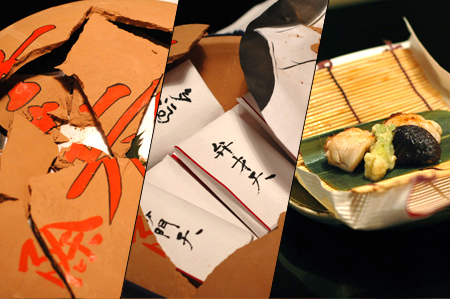Experiential Dining: Japan to America
Most restaurants offer diners the experience they desire for the evening. But taking away some control from diners allows a chef to craft an entire culinary experience. Break open your entree with a wooden mallet. Design your next course from a list of words. Who's in control?

Photo by Heather Sperling
Alinea is not a restaurant that encourages free will. In fact, we take most of it away for the evening to ensure the guests experience the restaurant as we intend. The most obvious example of this level of control is the menu. In most restaurants, this document's purpose is to outline options for the diner to custom-create the experience they desire for the evening. A choose-your-own adventure, if you will. But we want you to experience the adventure we have created, so we offer two progressions of 12 and 27 courses in length, with no choices to be made.
The dictation doesn't stop with the menu format. Clearly, if we are so adamant about what you should eat, then certainly we have to determine how the courses are sequenced, encourage guests to eat things in a certain order and from a specific orientation, with a specific paired beverage and using specially designed utensils, in a manipulated environment. We have to carefully choose language to describe the food about to be consumed, and even engulf the guests with selected smells to evoke emotion reactions that enhance the overall experience and solidify the vision.
"Wait," you're thinking. "This isn't dining! This sounds more like a psychology experiment. Clockwork Orange perhaps?"
Admittedly, it can sound a bit absurd on paper.
So why do we do all this?
The truth lies in the experience. It is rare that in today's world we give ourselves completely to someone's idea, and I think this surrender of choice can provide some exciting and rewarding results. We have a very specific vision for the overall experience Alinea should provide. In order to see that realized by our guests, we need to make sure that all of the elements are in place to support the vision. We need to control the experience fully.
Part board game, part gastronomic language exercise, this idea provides a fun, entertaining, engaging way for guests to control their destiny for a single course.
A few months ago, I started asking myself: is there a way to integrate choice into the menu while staying in control? Could it ultimately give us even more control, because the act inherently creates a new feeling and reaction? The idea I started bouncing around was essentially an "a la carte moment" in the midst of the tasting menu experience, which has previously been all about acquiescence and surrender. The aim is to give the diner a sense of freedom and control, which is a break in rhythm of the meal.
I was lucky enough to dine at the famous Kitcho restaurant in Kyoto while in Japan recently. This was my first foray into traditional kaiseki dining, and the experience was one of the best of my life. Rather then give you the play-by-play for the entire evening I want to focus on one course in particular that connected the contemporary and traditional dots for me. Midway through the meal, Andoni Luis Aduriz and I were given wooden mallets (not your typical eating utensil). The hostess explained that for the next course a large clay pot would be placed in the center of the long table. Andoni and I were to lead the group in a chant before using our mallets to break the clay and reveal the food inside. It was a fun, engaging activity that certainly elevated the tempo of the meal. The curiosity and excitement of the group peaked as they all participated in the experience vicariously.
Once the damage was done, the portions of fish, wrapped in layers of paper, a bamboo mat, and aromatic leaves, were removed from the destroyed vessel and served to the guest. I couldn't help but relate the event to a game of some sort. Sitting there eating the fish, I recalled the thoughts I had had months earlier involving the introduction of a similar concept to the meal at Alinea. After returning home from the trip I decided to pursue the idea aggressively, no doubt because of the enjoyment I experienced from being on the receiving end of this idea.
To help us achieve this we have developed the adjective concept. Part board game, part gastronomic language exercise, this idea provides a fun, entertaining, engaging way for guests to control their destiny for a single course.
Each guest at a table gets a card with four rows of six words. The rows are defined by characteristics. In the example below, from left to right: Row one is flavor, two is texture, three is emotionally driven, and four is temperature. As a group, the diners have to select one word from each category or row. Once the group has made a decision, they turn in their choices to the waiter. The waiter hands the choices to the kitchen, where we create a dish based on the guests' four choices. Soon after, the result of their choice--their exercise in limited free will--is served. Or will be.